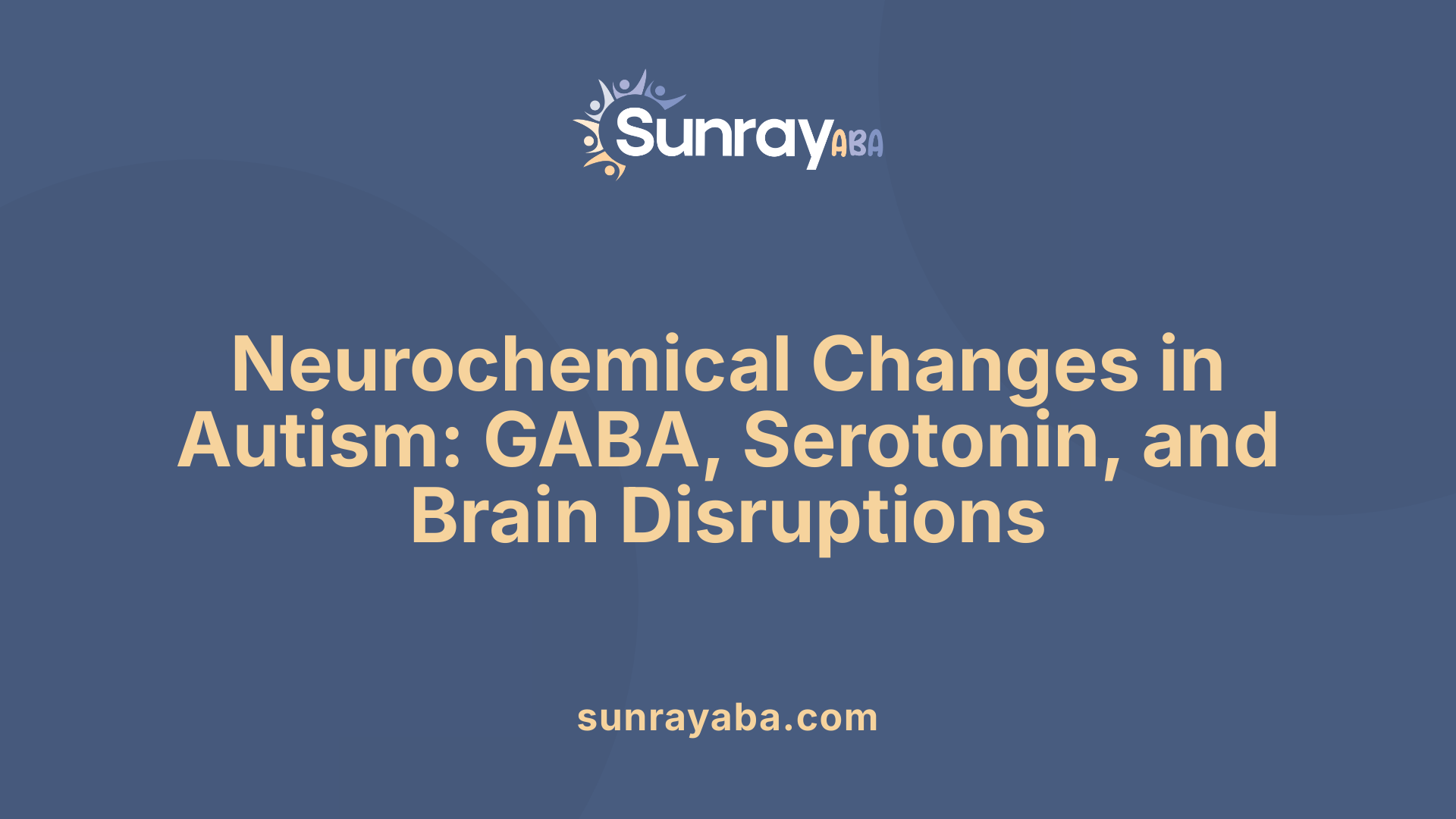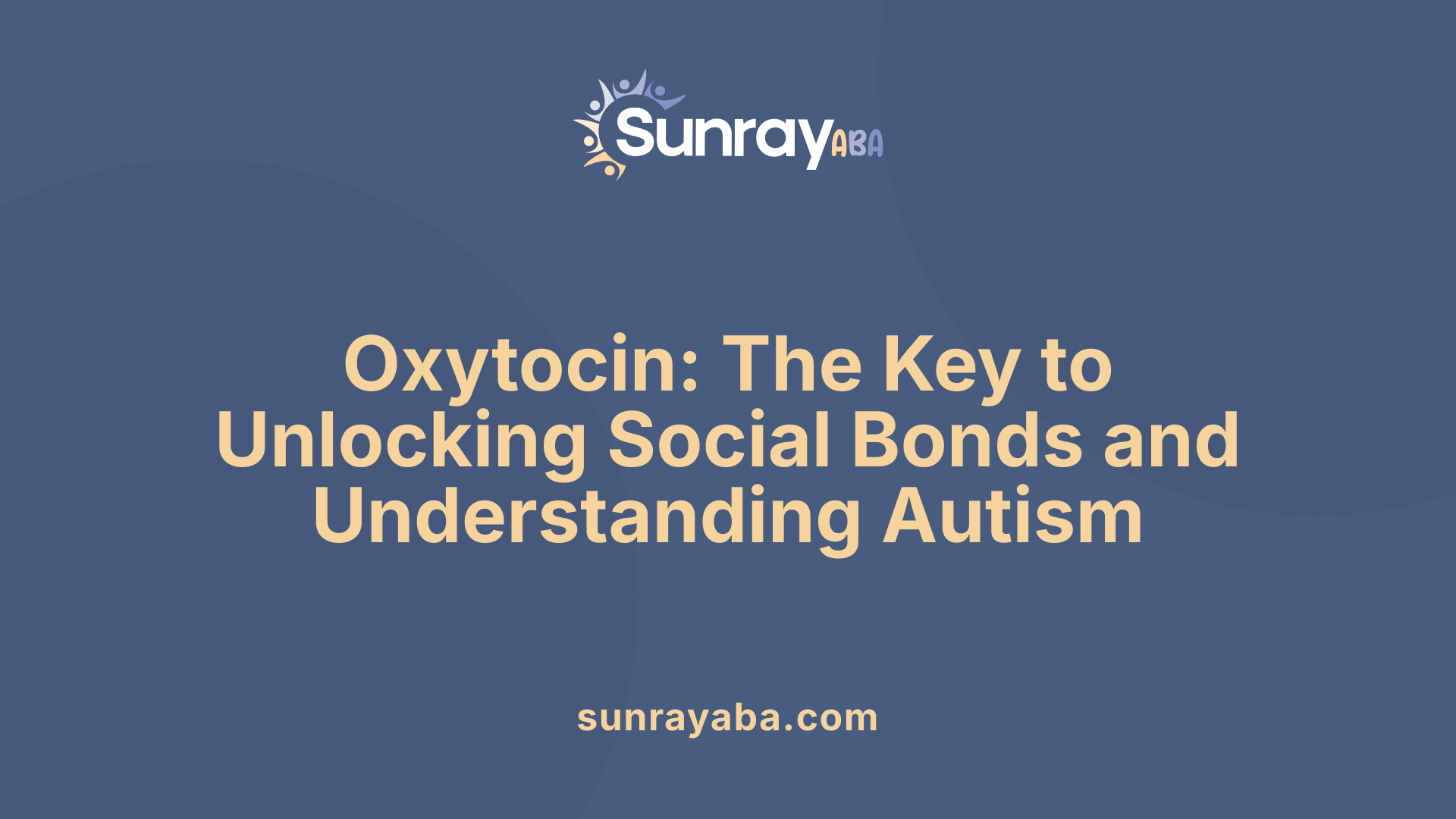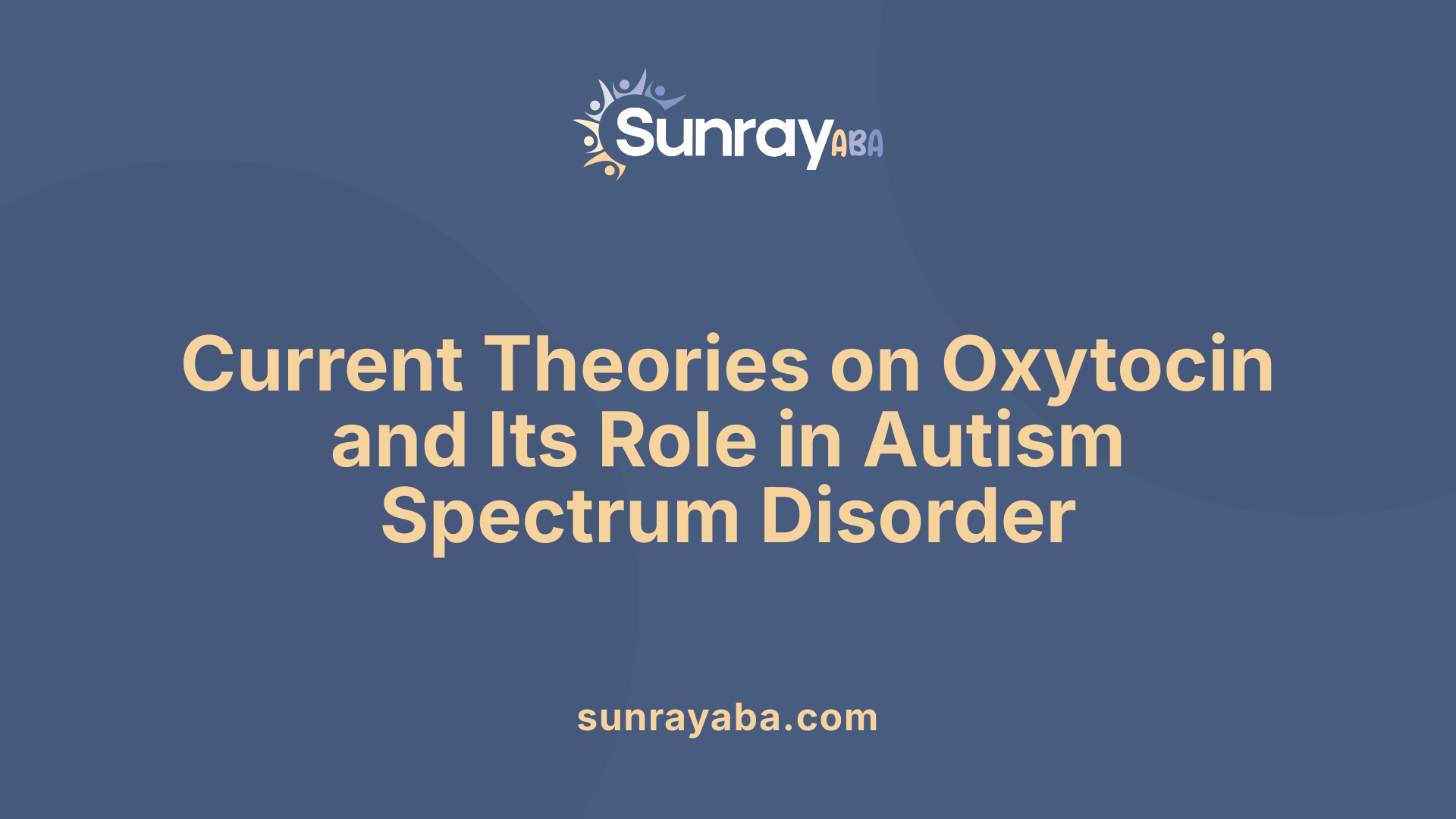Oxytocin's Link To Autism

Understanding the Oxytocin-Autism Connection
Oxytocin, often dubbed the 'love hormone,' plays a critical role in social bonding, trust, and emotional regulation. Its influence on social behaviors makes it a molecule of great interest in autism research, where social deficits are a core feature. Recent scientific advancements have begun to unravel how variations in oxytocin levels and receptor functioning may contribute to the complexities of Autism Spectrum Disorder (ASD). This article explores the current landscape of research, from biological mechanisms to clinical trials, highlighting oxytocin's potential as a biomarker and therapeutic agent.
Biochemical and Neurochemical Alterations in Autism

What is the evidence for alterations in neurotransmitters like serotonin and GABA in autism?
Research into the neurochemical landscape of autism spectrum disorder (ASD) reveals significant changes in key neurotransmitter systems, particularly GABA and serotonin. These alterations are believed to impact brain development and function, contributing to core symptoms of ASD.
One prominent area of study involves the GABAergic system, which is responsible for inhibitory signaling in the brain. Children with ASD often show abnormal GABA levels; for example, some studies report elevated plasma GABA levels, while imaging studies have found reduced GABA concentrations in certain brain regions associated with sensory processing and social behavior. Such imbalances can disturb the excitatory/inhibitory balance crucial for proper neural development.
Genetic research supports these findings, with mutations affecting GABA-related genes—such as those in MECP2, which are linked to Rett syndrome—highlighting GABA's role in ASD. Moreover, alterations in GABA receptor functioning and expression have been observed, indicating that the system's regulation is disrupted.
The serotonergic system also exhibits notable differences in autism. Elevated blood and brain serotonin levels are common, a condition known as hyperserotonemia. Additionally, studies have identified differences in serotonin receptor binding and transporter activity, pointing to serotonergic dysregulation. These aberrations might influence mood, anxiety, and social behaviors.
Animal models and neuroimaging studies further bolster the evidence, demonstrating that these neurochemical deviations can impair neural circuitry involved in social cognition, communication, and sensory integration.
Understanding these neurochemical alterations not only deepens our comprehension of ASD’s biological basis but also guides potential therapeutic strategies aimed at restoring neurotransmitter balance.
| Neurotransmitter | Typical Role in Brain | Alterations in Autism | Implications |
|---|---|---|---|
| GABA | Inhibition, calming | Elevated plasma GABA, reduced in brain regions | Affects sensory processing, excitatory/inhibitory balance |
| Serotonin | Mood, social behavior | Increased blood and brain levels, receptor and transporter differences | Influences anxiety, social motivation |
| GABA system genes | Neural inhibition | Mutations (e.g., in MECP2) | Disrupted neural inhibition and development |
| Serotonergic genes | Mood, cognition | Variants affecting receptor and transporter | Altered emotional regulation and social cognition |
Ongoing research continues to explore how these neurochemical differences can be targeted to improve autism symptoms.
The Significance of Oxytocin in Social Behavior

How does oxytocin act as a neuropeptide involved in social bonding and cognition?
Oxytocin is a hormone and neuropeptide that plays a critical role in promoting social bonds, trust, and emotional connection. It is released in the brain and body during social interactions, particularly during activities like bonding, lactation, and childbirth. In the brain, oxytocin influences various regions involved in social cognition, including the amygdala, prefrontal cortex, and fusiform gyrus. These areas help process social cues, recognize faces, and regulate emotional responses.
Research indicates that higher oxytocin levels are associated with increased social engagement, better emotion recognition, and enhanced feelings of attachment. Conversely, individuals with autism often show lower plasma oxytocin levels, which may contribute to difficulties in social interactions and recognition. Animal studies support these findings, showing that oxytocin facilitates behaviors like parental care, pair bonding, and social recognition memory.
What mechanisms through which oxytocin influence social behaviors such as trust, eye contact, and social recognition?
Oxytocin influences social behaviors primarily by acting on specific receptors located in brain circuits linked to social processing. When oxytocin binds to these receptors, it modulates neural activity in key areas:
- Amygdala: Oxytocin reduces activity here, decreasing fear and social anxiety, which encourages approach behaviors.
- Prefrontal Cortex: It enhances decision-making about social stimuli, promoting trust and empathetic responses.
- Fusiform Gyrus: Critical for face recognition, oxytocin increases gaze and attention toward the eyes and socially relevant facial features.
This hormonal action enhances social motivation by increasing the salience and rewarding nature of social stimuli. For example, it promotes eye contact and social recognition, which are often impaired in autism. Studies have shown that oxytocin administration results in increased gaze on faces, improved emotion recognition, and more trusting behaviors. These effects suggest that oxytocin acts as a modulator of social salience and emotional regulation.
How does the social motivation hypothesis (SMH) relate to oxytocin's role in social reward pathways?
The social motivation hypothesis (SMH) posits that individuals with autism experience diminished intrinsic reward from social stimuli, which hampers motivation to engage socially. This reduced social reward makes social interactions less appealing, leading to social withdrawal and communication difficulties.
Oxytocin is thought to influence this pathway by enhancing the salience and rewarding aspects of social stimuli. It activates the mesolimbic dopamine system, particularly structures like the nucleus accumbens, which are involved in processing pleasure and reward. By boosting activity in these areas during social encounters, oxytocin can increase the perceived value of social interactions.
Evidence from studies shows that oxytocin administration increases activity in reward-related brain regions during social tasks, supporting its potential to restore social motivation. This aligns with the idea that oxytocin enhances the intrinsic reward value of social stimuli, potentially addressing one of the core deficits in autism. Overall, oxytocin may help to reinstate the natural reward response to social cues, encouraging greater social engagement and reducing social deficits.
How do biological mechanisms link oxytocin to autism symptoms?
The connection between oxytocin and autism symptoms involves complex neural circuits that regulate social behavior. In autistic individuals, research has identified lower levels of oxytocin or abnormalities in oxytocin receptor function, such as mutations or altered receptor expression ( OXTR"). These deficits impair the brain's social processing capabilities.
Specifically, reduced oxytocin access to key brain regions like the amygdala may lead to heightened social anxiety, diminished trust, and difficulties in recognizing social cues. Similarly, abnormalities in the regulation of oxytocin receptor gene methylation can affect receptor density and signaling.
Experimental intranasal oxytocin treatments temporarily elevate central oxytocin activity, leading to improved social behaviors, increased eye gaze, and decreased social anxiety. Moreover, studies show that chronic oxytocin administration can result in increased oxytocin receptor expression by reducing OXTR DNA methylation, suggesting that sustained treatment could produce longer-lasting changes.
In summary, the biological mechanisms linking oxytocin to autism involve modulation of neural circuits responsible for social cognition, emotional regulation, and reward processing. These pathways are often disrupted in autism, and targeting them with oxytocin offers a promising approach to alleviating core social symptoms.
Exploring the Current Theories and Understanding of Oxytocin's Role in ASD

What current scientific understanding and theories explain oxytocin's effect on autism spectrum disorder?
Oxytocin is a neuropeptide that plays a significant role in social bonding, trust, and emotional recognition in both animals and humans. Researchers believe that problems in the oxytocin system may contribute to social difficulties observed in individuals with autism spectrum disorder (ASD).
One prominent theory is the social motivation hypothesis (SMH), which suggests that autistic individuals find social stimuli less rewarding due to impairments in the oxytocin system. This reduced social reward diminishes motivation to engage socially, leading to broader deficits in social communication and interaction.
Biological studies support this idea by showing that many people with ASD have lower levels of oxytocin in their blood or cerebrospinal fluid. Some genetic variations in the oxytocin receptor gene (OXTR) are also associated with ASD severity, although findings are still tentative and require further investigation.
Animal studies provide compelling evidence that deficits in oxytocin signaling pathways impair social recognition and bonding behaviors. For example, rodents lacking functional oxytocin receptors exhibit social recognition deficits, which can be rescued by administering oxytocin.
In humans, interventions such as intranasal oxytocin administration have been tested to improve social cognition and attention. These studies have shown that oxytocin can temporarily enhance eye gaze, emotion recognition, and social cooperation, especially in those with lower baseline oxytocin levels.
However, the clinical outcomes are inconsistent, and the long-term effects of oxytocin treatment remain unclear. Variability in individual responses suggests that oxytocin's effects are complex and influenced by genetic, neurobiological, and environmental factors.
In summary, the current understanding approves oxytocin as a modulator of social behavior, with dysregulation in its system contributing to the social impairments in ASD. While promising, further research is needed to translate these biological insights into effective and personalized therapies.
Genetic variations in oxytocin receptor genes (OXTR) and their correlation with ASD severity
Genetic studies have explored the connection between the oxytocin receptor gene (OXTR) and ASD. Certain polymorphisms in OXTR have been associated with differences in social functioning and ASD severity. For instance, some variants might reduce receptor efficiency or expression, leading to diminished oxytocin signaling.
Research findings indicate that individuals with specific OXTR polymorphisms tend to show greater social impairments and reduced responsiveness to social stimuli. Nevertheless, results vary across studies, and the genetic influence appears to be modest, with many other factors involved.
This area remains active, with ongoing efforts to identify genetic markers that could predict treatment response or severity. Better understanding of how these variations influence receptor function may facilitate more tailored interventions.
Animal model studies demonstrating oxytocin deficits leading to social impairments
Animal models, especially rodents, have been instrumental in understanding the role of oxytocin in social behavior. Mice lacking the oxytocin gene or its receptor exhibit significant social deficits, such as decreased social interaction and impaired social recognition.
Conversely, administering oxytocin or modulating its pathways can improve social behaviors in these models. For example,
- Restoring oxytocin signaling in deficient mice leads to improvements in social memory.
- Conversely, animals with disrupted oxytocin systems demonstrate increased anxiety and decreased social engagement.
These studies confirm that oxytocin is crucial for normal social functioning and that its deficits can cause social impairments similar to those observed in ASD. They also support the potential for oxytocin-based therapies to mitigate social deficits.
| Aspect | Findings | Implications |
|---|---|---|
| Animal models | Oxytocin deficiency causes social impairments | Validates oxytocin's role in social behavior |
| Oxytocin administration | Rescues social deficits in models | Supports potential therapeutic effects |
| Genetic studies | Variations in OXTR linked to social severity | Guides personalized treatment approaches |
| Human studies | Oxytocin temporarily improves social cognition | Highlights therapeutic potential but indicates complexity |
Continued research in this area aims to better understand how these findings can be translated into effective treatments for ASD.
Potential of Oxytocin as a Biomarker for Autism
 Research into oxytocin’s role in autism spectrum disorder (ASD) suggests that it could serve as a useful biological marker to aid in diagnosis and treatment planning.
Research into oxytocin’s role in autism spectrum disorder (ASD) suggests that it could serve as a useful biological marker to aid in diagnosis and treatment planning.
Blood and cerebrospinal fluid (CSF) oxytocin levels have been examined as potential indicators of autism. Studies show that children with ASD often display altered oxytocin levels, especially during social or stress-inducing situations. For example, research indicates that morning oxytocin levels are lower in children with autism compared to neurotypical controls, and that fluctuations in oxytocin can be linked to social stress responses. These findings point to the potential of measuring oxytocin levels to assess social impairment severity.
In addition to neurochemical markers, genetic variations in oxytocin-related genes, particularly the oxytocin receptor gene (OXTR), are associated with ASD risk. Certain polymorphisms and copy number variations (CNVs) in OXTR and other related genes like CD38 have been linked to differences in social behavior and oxytocin functioning. These genetic markers can not only help identify individuals who might be more prone to social deficits but also predict their potential responsiveness to oxytocin-based therapies.
Treatment response prediction is another promising application of oxytocin as a biomarker. Clinical trials have observed that children with lower baseline oxytocin levels tend to show more significant social improvements following oxytocin administration. This suggests that measuring baseline oxytocin levels might help determine which children will benefit most from therapy. However, results are mixed, as some studies have found no significant differences in plasma oxytocin levels between autistic and control groups, highlighting the complexity of using oxytocin as a standalone biomarker.
Thus, integrating measures of blood or CSF oxytocin levels with genetic data and behavioral assessments could enhance the accuracy of ASD diagnosis and help tailor personalized treatment strategies. Although promising, further large-scale and longitudinal studies are needed to validate these biomarkers before they become routine clinical tools.
| Biomarker Type | Findings | Relevance | Notes |
|---|---|---|---|
| Blood oxytocin levels | Variability; lower levels in some autistic children | Diagnostic support; treatment predictor | Changes with social stress; fluctuates during the day |
| CSF oxytocin | Less studied, but shows promise in research | Potential indicator of central oxytocin activity | More invasive to obtain |
| Genetic markers (OXTR polymorphisms) | Associated with ASD risk; variations affect social behavior | Genetic risk assessment; therapy response | Some variants linked to altered receptor function |
| Treatment prediction | Baseline low oxytocin linked to better response | Personalized therapy | Not yet routinely used in clinics |
Research into these biomarkers continues to evolve, promising more personalized and effective approaches in autism diagnosis and management.
Neurochemical Impact of Oxytocin on Autism Symptoms

How does the neurochemical mechanism of oxytocin impact autism?
Oxytocin, often called the social hormone, plays a crucial role in modulating brain activity related to social behavior. In individuals with autism, many studies point to altered oxytocin levels and dysfunctional oxytocin signaling pathways that contribute to difficulties in social recognition, communication, and emotional regulation.
The neurochemical mechanism of oxytocin chiefly influences key brain regions involved in social cognition. These include the amygdala, medial prefrontal cortex, and reward centers like the striatum. When oxytocin binds to its receptors in these areas, it can enhance neural activity, which helps improve social motivation and responsiveness.
Research demonstrates that exogenous oxytocin administration — often via nasal spray — can partially boost activity in these neural circuits. For example, neuroimaging studies show increased activity in the amygdala and prefrontal cortex during social tasks after oxytocin treatment. This heightened activity correlates with better emotion recognition and social engagement.
Animal models provide further insight into the pathways involved. In these models, deficits in endogenous oxytocin or mutations affecting the oxytocin receptor gene (OXTR) impair social recognition and bonding. Administering oxytocin can rescue these behaviors, suggesting that boosting oxytocin levels enhances neuronal connectivity and energy demand in relevant circuits.
Genetic variations in OXTR are associated with social impairments in autism. These genetic differences may alter receptor function or expression, impacting how brain regions respond to oxytocin. Therefore, individual genetic profiles can influence treatment responsiveness.
Oxytocin's influence on neural activity isn't limited to increasing activity levels. It also modulates the salience and hedonic evaluation of social stimuli, making social cues like facial expressions more meaningful. This effect supports the social motivation hypothesis, proposing that oxytocin enhances intrinsic reward from social interactions.
Though promising, the pathway from oxytocin administration to behavioral improvement involves complex neurochemical dynamics. It involves not just receptor activity but also interactions with other neurotransmitter systems, such as dopamine, which are vital for reward processing.
In sum, oxytocin impacts autism primarily through its modulating effects on neural circuits that underpin social cognition, attention, and motivation. By influencing activity in the amygdala, prefrontal cortex, and reward systems, it can help overcome some social deficits characteristic of autism. However, individual differences, such as genetic makeup and baseline oxytocin levels, play significant roles in determining the extent of these neurochemical effects.
Clinical Evidence Supporting Oxytocin's Role in Autism
Research involving controlled clinical trials and animal studies provides valuable insights into how oxytocin influences social behaviors associated with autism. Several clinical trials have investigated the effects of intranasal oxytocin, revealing that this hormone can temporarily enhance social engagement, improve eye gaze, and bolster emotion recognition in some individuals with autism. For instance, one notable study involved 32 children with autism, where four weeks of oxytocin treatment led to increased salivary oxytocin levels and improvements in social conduct, particularly among children with initially low oxytocin levels.
Animal studies complement these findings by demonstrating causal links between the oxytocin system and social functioning. Mice genetically modified to have reduced oxytocin or defective oxytocin receptors exhibit social recognition deficits and impaired social behaviors. Notably, these behaviors can be rescued with oxytocin treatment, supporting the idea that the hormone plays a vital role in social bonding and recognition.
In models like Shank3 knockout mice, which mimic some autism symptoms, oxytocin administration has alleviated social impairments. Further, experiments show that oxytocin influences brain activity in regions implicated in social processing, such as the amygdala and prefrontal cortex.
However, the clinical evidence is mixed. Some studies report significant improvements, while others find little or no effect after treatment. Variability in findings is often due to differences in dosage, duration, administration method, and participant characteristics. Despite these mixed results, both research areas suggest that modulating the oxytocin system holds promise as a strategy to address social deficits in autism.
| Study Type | Main Findings | Limitations and Notes |
|---|---|---|
| Clinical Trials | Improvements in eye gaze, emotional recognition, social engagement | Effects are often transient; individual variability exists |
| Animal Models | Rescue of social recognition deficits with oxytocin treatment | Human implications require cautious interpretation |
| Genetic Studies | Associations between oxytocin receptor gene polymorphisms and autism | Findings are tentative, further research needed |
Overall, the combined evidence points to a potential role for oxytocin in improving social behaviors in autism, but more rigorous and large-scale studies are crucial for determining its therapeutic viability.
Limitations and Future Directions in Oxytocin Research
Current research on using oxytocin to help individuals with autism faces several challenges that need to be addressed to better understand its effectiveness and optimize treatment strategies.
Many studies conducted so far involved small participant groups, which limits the statistical power and reliability of the findings. For example, systematic reviews and meta-analyses have shown that while some evidence suggests oxytocin can improve social behaviors, the results are often inconsistent or inconclusive. This variability complicates efforts to determine whether oxytocin is a broadly effective therapy.
Heterogeneity among different trials adds to these difficulties. Factors such as the dose of oxytocin used, the duration of treatment, and the method of administration (mainly nasal spray) can influence outcomes. For instance, some studies report benefits in social cognition and eye gaze, while others show no significant effects compared to placebo.
Another limitation is the variation in how studies measure improvements, including differences in behavioral assessments and biomarker analyses. This inconsistency makes it hard to synthesize data or establish standardized treatment protocols.
Given these constraints, researchers emphasize the importance of conducting larger, well-designed, pre-registered clinical trials. Such studies should employ rigorous methodology to accurately evaluate oxytocin's potential benefits and risks.
Looking ahead, a promising area of research involves tailoring treatments to individual profiles. Genetic factors, such as variations in the oxytocin receptor gene (OXTR), may influence how children respond to oxytocin therapy.
Developing personalized approaches could involve combining oxytocin treatment with behavioral interventions, aiming to enhance and prolong social improvements. Optimizing dosing schedules, administration routes, and treatment durations are critical steps.
Furthermore, integrating biological markers—like blood oxytocin levels or epigenetic changes, such as OXTR methylation—may help identify which children are most likely to benefit from treatment.
In summary, advancing oxytocin research requires larger, more rigorous studies and exploring individual differences to improve clinical outcomes. These efforts aim to transform current mixed results into effective, personalized therapies for autism spectrum disorder.
Pharmacological and Ethical Considerations
How is oxytocin prescribed and monitored in clinical settings, and what are the concerns?
Oxytocin is generally prescribed by healthcare professionals such as general practitioners, psychiatrists, or pediatricians. These professionals are responsible for overseeing treatment to ensure safety and effectiveness.
Most research and clinical practice involve administering oxytocin through a nasal spray, which allows for direct delivery to the brain. Besides nasal sprays, other forms like injections and lozenges are also used, depending on the context and specific treatment goals.
Treatment duration varies widely across studies and clinical applications. Some protocols involve a few weeks of twice-daily doses, while others explore longer-term administration. Regular monitoring is crucial to identify any adverse effects early.
Potential side effects of oxytocin therapy include allergic reactions, increased water intake leading to water intoxication, seizures, and changes in heart rate variability. There are also concerns about the possibility of psychotic symptoms emerging in some cases.
Healthcare providers need to remain vigilant for these adverse reactions, adjusting treatment as necessary. They must also educate patients and caregivers about potential risks.
Cost considerations significantly influence accessibility. Prices vary depending on the formulation—such as nasal spray, injectable, or lozenge—and on healthcare coverage and regional healthcare policies.
Access to oxytocin therapy can be limited by these costs, and not all patients may afford or obtain the treatment. This raises ethical questions about ensuring equitable access, especially for individuals who might benefit most.
Given these concerns, strict regulation, careful patient selection, and thorough monitoring are essential. Developing clear clinical guidelines and patient education programs helps prevent misuse and ensures safety during oxytocin therapy for autism and other conditions.
Genetic Factors and Oxytocin System Disruptions in Autism
Research has identified genetic links between the oxytocin system and autism spectrum disorder (ASD), particularly involving the oxytocin receptor gene (OXTR) and the CD38 gene. These genes play roles in the production, regulation, and receptor functioning of oxytocin, a neuropeptide crucial for social bonding, trust, and emotional recognition.
Studies have shown that certain polymorphisms in the OXTR gene are associated with increased risk for ASD and may influence how individuals respond to oxytocin-based treatments. Variations in these genetic markers can alter receptor sensitivity or expression levels, impacting social cognition, attachment, and social motivation.
Mutations affecting the synthesis and processing of oxytocin can also contribute to the neurochemical imbalances seen in autism. Some mutations may impair the production or release of oxytocin, reducing its availability in the brain and thus diminishing social motivation and bonding behaviors.
Genetic variability not only influences susceptibility to autism but also the potential effectiveness of oxytocin therapies. Individuals with certain genetic profiles may respond better or worse to oxytocin administration, highlighting the importance of personalized approaches in treatment.
Ongoing research aims to clarify the relationship between these genetic factors and autism outcomes. Understanding how variations in OXTR and related genes affect oxytocin functioning could lead to more targeted interventions and improve the prognosis for individuals with ASD.
In summary, the complex genetic landscape involving OXTR mutations and other related genes shapes how the oxytocin system operates in autism. This knowledge paves the way for more precise diagnostics and personalized treatments, optimizing social behaviors and attachment in affected individuals.
The Promise and Challenges of Harnessing Oxytocin in Autism
While current evidence underscores oxytocin's crucial role in social behavior and its potential as a therapeutic target for autism, significant challenges remain. Variability in individual responses, methodological differences in research, and incomplete understanding of the neurochemical mechanisms call for more rigorous, large-scale studies. Future research aimed at personalized medicine, integrating genetic, neurochemical, and behavioral data, promises to unlock effective interventions. As the science advances, oxytocin may yet become a cornerstone in managing the social symptoms of autism, but ethical considerations and safety protocols must guide its clinical application.
References
- Study shows which children with autism respond best to oxytocin ...
- Chronic oxytocin administration stimulates the oxytocinergic system ...
- Research Review: Social motivation and oxytocin in autism
- Oxytocin and autism: Insights from clinical trials and animal models
- Can oxytocin help improve social skills in kids with autism? It's ...
- Association of Epidural Analgesia, Oxytocin, and Risk of Autism ...
- Oxytocin and Autism Spectrum Disorders - PubMed
- Oxytocin therapy and autism | Raising Children Network